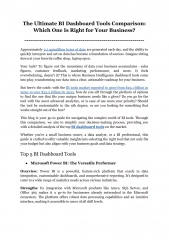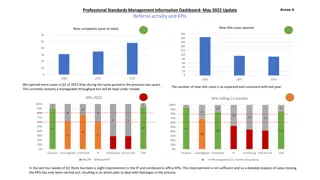Understanding Dashboard Terminology for December 2020
Exploring the dashboard terminology for December 2020, including concepts like the orange ring of dartboard for domain tabs, the center and rings of dartboard on domain tabs, the green ring of dartboard for Mori Health Equity Report, and more. Learn about the significance of different indicators and values represented on the dashboard.
Download Presentation

Please find below an Image/Link to download the presentation.
The content on the website is provided AS IS for your information and personal use only. It may not be sold, licensed, or shared on other websites without obtaining consent from the author. Download presentation by click this link. If you encounter any issues during the download, it is possible that the publisher has removed the file from their server.
E N D
Presentation Transcript
Dashboard terminology December 2020
Contents Orange ring of dartboard for domain tabs Centre and rings of dartboard on domain tabs Green ring of dartboard on M ori Health Equity Report Centre and rings of dartboard on M ori Health Equity Report O/E ratio Equity tab: significant difference Standard deviation
Orange ring of dartboard for domain tabs The orange ring is defined in different ways for different indicators on the dartboard of the domain tabs. National rate (per xx population) National numerator/national denominator per xx population National average Average of all the DHB scores O/E ratio Difference between national value and 1
Centre and rings of dartboard on domain tabs The centre is three standard deviations better than the national average (orange ring). When an indicator achieves the ideal level (best possible result), it has two possible presentations. Firstly, if it is three or more standard deviations better than the national average, then it is presented exactly on the bullseye. Secondly, when it is better than the national average, but not quite three standard deviations better, its position is represented by how many standard deviations better it is. There are different ideal levels between indicators depending on their measures. Ideal = 0 for: Indicators with an O/E ratio Some safety, access and effectiveness indicators measuring harm Ideal = 10 for: Some patient-centred indicators giving scores out of 10 Ideal = 100% for: Some patient-centred and safety process indicators
Green ring of dartboard for Mori Health Equity Report The green ring is defined as the value of the reference group for the M ori Health Equity Report. The reference group can be the values of indicators of non-M ori non-Pacific groups in the selected DHB to keep the comparison at a local level; or it can the value of the non-M ori non-Pacific national average to bring the comparison to the national scale. As the comparison sides are switchable, the reference group also can be the values of the indicators for M ori in the selected DHB when setting up non- M ori non-Pacific as the equity group.
Centre and rings of dartboard on Mori Health Equity Report In simple terms, the green ring represents equity, which means the values of an indicator are the same for the equity group and reference group. The distance between the centre of the dartboard and the indicator is defined differently across indicators. When the value of the indicator is a rate, the distance is a rate ratio. The green ring represents these ratios equal 1. For a percentage, the distance is the ratio of two differences. The first difference is the difference between the equity group percentage and the reference group percentage. The second difference is the difference between the reference group percentage and the ideal percentage. The green ring represents 0 for these ratios when equity group percentage equals reference group. If lower is better for an indicator, then indicators with ratios less than 1 (0 for a percentage) will be inside the green ring. Otherwise indicators with ratios greater than 1 (0 for a percentage) will be outside the green ring. The opposite is true for indicators where higher is better . For the life expectancy indicator, the rings outside the green ring represent 5 and 10 years shorter life expectancy respectively. The rings inside represent 5 and 10 years longer life expectancy respectively. An extreme value of the ratio is truncated to be just outside the boundary of the dartboard to make sure it is included. More complex calculations than above descriptions have been applied to scale indicators on the same dartboard.
O/E ratio The O/E (observed/expected) ratio is a ratio of the number of observed cases to the number of expected cases. The orange ring of the O/E ratio is the difference between the national value and 1. The ideal level of the O/E ratio is 0. Any DHB that is better than (within) the orange ring has an O/E ratio that is less than the national O/E ratio.
Equity tab: significant difference The domain equity tabs present the comparison results of an equity group and a reference group. The equity group can be set as M ori or Pacific peoples. The reference group can be set as non-M ori non-Pacific NZ average or DHB average. The confidence interval and p value for testing a significant rate difference are calculated as follows. ? ? 2 1.96) , where u and l are the upper and lower CI: ???? ?????????? 1.96 ( limits of a 95% CI respectively. ???? ?????????? ? ? 2 1.96) p = ? 0.717? 0.416?2, where ? = ** ( If p > 0.05, then the difference is not statistically significant, otherwise it is. * Aschengrau A, Seage GR. 2003. Essentials of Epidemiology in Public Health. Jones and Bartlett Publishers. ** https://www.bmj.com/content/343/bmj.d2304
Standard deviation Standard deviation indicates how much the DHBs vary from the national average for a certain indicator. The bigger the standard deviation, the more the DHBs vary against the national average. The smaller the standard deviation, the closer the DHBs are to the national average.
Standard deviation formula The standard deviation for each indicator is calculated based on the DHB values as the population using the formula: ?(?? ?)2 ? ?=1 = ? is the standard deviation ?? is each DHB value ? is the value of the national mean ? = 1,2, ?. ? is the number of the DHBs with available data
Z-score A z-score indicates how many standard deviations a value is away from the orange ring. These scores are the results of standardising the DHB values distribution. Note: All the DHB values are represented on the dartboard using z-scores from a standard normal distribution.























